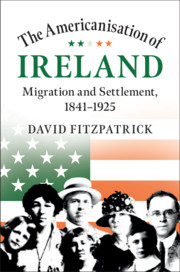Book contents
- The Americanisation of Ireland
- The Americanisation of Ireland
- Copyright page
- Contents
- Charts, Maps and Tables
- Prologue: Ireland’s American Question
- 1 Beyond Emigration
- 2 Cosmopolitan Ireland, 1841–1911
- 3 America on Show, 1901–11: Profile
- 4 America on Show: People
- 5 America on Show: Special Cases
- 6 Americans in Leitrim, 1901–11: Profile
- 7 Americans in Leitrim: People
- 8 Visitors from America, 1914–25: Profile
- 9 Visitors from America: Motives
- 10 Visitors from America: Faces
- Epilogue: Questions Unanswered
- Notes
- Index
- Plate Section (PDF Only)
Epilogue: Questions Unanswered
Published online by Cambridge University Press: 16 December 2019
- The Americanisation of Ireland
- The Americanisation of Ireland
- Copyright page
- Contents
- Charts, Maps and Tables
- Prologue: Ireland’s American Question
- 1 Beyond Emigration
- 2 Cosmopolitan Ireland, 1841–1911
- 3 America on Show, 1901–11: Profile
- 4 America on Show: People
- 5 America on Show: Special Cases
- 6 Americans in Leitrim, 1901–11: Profile
- 7 Americans in Leitrim: People
- 8 Visitors from America, 1914–25: Profile
- 9 Visitors from America: Motives
- 10 Visitors from America: Faces
- Epilogue: Questions Unanswered
- Notes
- Index
- Plate Section (PDF Only)
Summary
This book has portrayed an American expatriate population very different from the cultural emissaries of American values to be found in nineteenth-century Britain or Europe. Only a small, if fascinating, minority belonged to the mainly urban elite that dominated American settlement elsewhere. Ireland was surely the only European country whose American-born population was overwhelmingly shaped by previous emigration. As revealed by passport applications, this also applied to American citizens of rural Irish birth who visited Ireland in the aftermath of the First World War. Both groups were strikingly representative of the rural poor from which they had sprung, and among whom they lived when ‘at home’ in Ireland. At least in the case of the thousands of American-born children and sometimes their parents who sheltered with Irish kinsfolk in the early twentieth century, Ireland’s ‘Americans’ were more likely to be regarded with pity than with envy, being apparently ‘losers’ in the game of international migration. This fundamental contrast to the prevailing stereotype of American wealth and success meant that ‘Americanisation’ was a far darker experience in Ireland than in Britain. Yet it was also more solidly grounded in personal interaction and direct observation, because the American human presence was proportionately far greater and more diffused in Ireland.
- Type
- Chapter
- Information
- The Americanisation of IrelandMigration and Settlement, 1841–1925, pp. 211 - 213Publisher: Cambridge University PressPrint publication year: 2019



